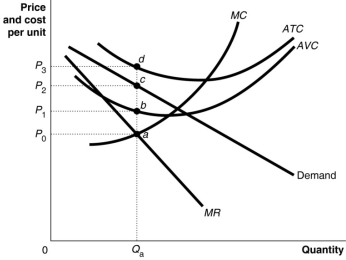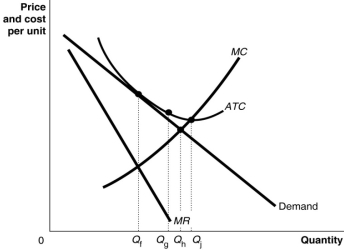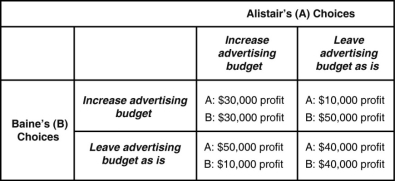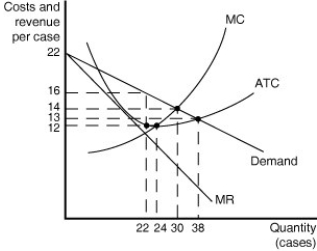A) The output effect
B) The price effect
C) The income effect
D) The substitution effect
F) B) and C)
Correct Answer

verified
Correct Answer
verified
Multiple Choice
Which of the following is an example of implicit collusion?
A) Product differentiation
B) A retaliation strategy
C) A second-price auction
D) Price leadership
F) A) and C)
Correct Answer

verified
Correct Answer
verified
Multiple Choice
Why are oligopolies difficult to analyse?
A) The firms are so large.
B) Demand and cost curves do not exist for these types of industries.
C) How firms respond to a price change by a rival is uncertain.
D) Oligopolies are a recent development so economists have not had time to develop models.
F) B) and D)
Correct Answer

verified
Correct Answer
verified
True/False
New firms are able to enter monopolistically competitive markets because there are low barriers to entry.
B) False
Correct Answer

verified
Correct Answer
verified
Multiple Choice
In long-run equilibrium,compared to a perfectly competitive market,a monopolistically competitive industry produces a ________ level of output and charges a ________ price.
A) higher; lower
B) lower; lower
C) lower; higher
D) higher; higher
F) A) and C)
Correct Answer

verified
Correct Answer
verified
Multiple Choice
Which of the following is not part of an oligopolist's business strategy?
A) Deciding on how to manage relations with suppliers
B) Choosing what new technologies to adopt
C) Selecting which new markets to enter
D) Independently setting a product's price without consideration of its rivals' pricing policies
F) B) and D)
Correct Answer

verified
Correct Answer
verified
Multiple Choice
A patent is an example of ________.
A) how ownership of a key input creates a barrier to entry
B) a government-imposed barrier to entry
C) occupational licensing
D) how market failure can lead to oligopoly
F) C) and D)
Correct Answer

verified
B
Correct Answer
verified
Multiple Choice
One reason why the coffeehouse market is competitive is that _______.
A) demand for specialty coffee is very high
B) it is trendy and therefore is likely to have a customer following
C) barriers to entry are low
D) consumption takes place in public
F) B) and C)
Correct Answer

verified
Correct Answer
verified
Multiple Choice
Figure 9.13  Figure 9.13 shows short-run cost and demand curves for a monopolistically competitive firm in the market for designer watches.
-Refer to Figure 9.13.If the diagram represents a typical firm in the designer watch market,what is likely to happen in the long run?
Figure 9.13 shows short-run cost and demand curves for a monopolistically competitive firm in the market for designer watches.
-Refer to Figure 9.13.If the diagram represents a typical firm in the designer watch market,what is likely to happen in the long run?
A) Some firms will exit the market causing the demand to increase for firms remaining in the market.
B) The firms that are incurring losses will be purchased by their more successful rivals.
C) Inefficient firms will exit the market, and new cost efficient firms will enter the market.
D) Firms will have to raise their prices to cover costs of production.
F) B) and C)
Correct Answer

verified
Correct Answer
verified
Multiple Choice
A table that shows the possible payoffs each firm earns from every combination of strategies by all firms is called ____________.
A) an earnings table
B) a payoff table
C) a payoff matrix
D) a strategic matrix
F) A) and D)
Correct Answer

verified
Correct Answer
verified
Multiple Choice
For the monopolistically competitive firm,_______.
A) Price (P) = Marginal Revenue (MR) = Average Revenue (AR)
B) P = MR > AR
C) P = AR > MR
D) P > MR = AR
F) B) and D)
Correct Answer

verified
C
Correct Answer
verified
Multiple Choice
Suppose we want to use game theory to analyse how an oligopolist selects its optimal price.The cells of the payoff matrix show ________.
A) the profit that each producer can expect to earn by pursuing a single strategy
B) the profit that each producer can expect to earn from every combination of strategies by the firms in the market
C) the strategy that a firm must pursue to earn various levels of profit
D) the expected profits of rival firms
F) A) and C)
Correct Answer

verified
Correct Answer
verified
Multiple Choice
Figure 9.17  -Refer to Figure 9.17.The allocatively efficient output for the firm represented in the diagram is _____.
-Refer to Figure 9.17.The allocatively efficient output for the firm represented in the diagram is _____.
A) Qf units
B) Qg units
C) Qh units
D) Qj units
F) A) and D)
Correct Answer

verified
Correct Answer
verified
Multiple Choice
Table 9.3  Firm A(Alistair's) and Firm B (Baine's) are the only firms selling luggage in the upscale town of Adelaide. Each firm must decide on whether to increase its advertising spending to compete for customers. If one firm increases its advertising budget but the other does not, then the firm with the higher advertising budget will increase its profit. Table 9.3 shows the payoff matrix for this advertising game.
-Refer to Table 9.3.The Nash equilibrium in this game is:
Firm A(Alistair's) and Firm B (Baine's) are the only firms selling luggage in the upscale town of Adelaide. Each firm must decide on whether to increase its advertising spending to compete for customers. If one firm increases its advertising budget but the other does not, then the firm with the higher advertising budget will increase its profit. Table 9.3 shows the payoff matrix for this advertising game.
-Refer to Table 9.3.The Nash equilibrium in this game is:
A) There is no Nash equilibrium.
B) Baine increases its advertising budget, but Alistair does not.
C) Alistair increases its advertising budget, but Baine does not.
D) Both Alistair and Baine increase their advertising budgets.
F) B) and C)
Correct Answer

verified
Correct Answer
verified
Multiple Choice
Figure 9.8  Figure 9.8 shows cost and demand curves for a monopolistically competitive producer of iced tea.
-Refer to Figure 9.8.Based on the diagram,one can conclude that _______.
Figure 9.8 shows cost and demand curves for a monopolistically competitive producer of iced tea.
-Refer to Figure 9.8.Based on the diagram,one can conclude that _______.
A) some existing firms will exit the market
B) new firms will enter the market
C) the industry is in long-run equilibrium
D) firms achieve productive efficiency
F) A) and C)
Correct Answer

verified
Correct Answer
verified
Multiple Choice
Figure 9.8  Figure 9.8 shows cost and demand curves for a monopolistically competitive producer of iced tea.
-Refer to Figure 9.8.The profit-maximising output level is ______.
Figure 9.8 shows cost and demand curves for a monopolistically competitive producer of iced tea.
-Refer to Figure 9.8.The profit-maximising output level is ______.
A) 22 cases
B) 24 cases
C) 30 cases
D) 38 cases
F) None of the above
Correct Answer

verified
Correct Answer
verified
Multiple Choice
What happens when large firms in oligopoly markets cut their prices?
A) Rival firms will also cut their prices to avoid losing sales.
B) Rival firms will not change their prices because most of their customers have signed contracts that commit them to doing business with the same firms for the life of their contracts.
C) We don't know for sure how rival firms will respond.
D) Rival firms will not cut their prices because they fear that the federal government will accuse them of collusion.
F) B) and C)
Correct Answer

verified
Correct Answer
verified
Multiple Choice
When does collusion occur?
A) When a firm chooses a level of output to maximise its own profit
B) When two firms' price and output decisions come into conflict
C) When there is an agreement among firms to charge the same price or otherwise not to compete
D) When firms refuse to follow their price leaders
F) A) and D)
Correct Answer

verified
Correct Answer
verified
True/False
A monopolistically competitive firm can increase its profits beyond the long-run equilibrium break-even level by deliberately lowering its price to force some of its competitors out of the market.
B) False
Correct Answer

verified
Correct Answer
verified
Multiple Choice
When a firm faces a downward-sloping demand curve,marginal revenue __________.
A) must exceed price because the price effect outweighs the output effect
B) is less than price because a firm must lower its price to sell more
C) equals price because the firm sells a standardised product
D) must exceed price because the output effect outweighs the price effect
F) B) and D)
Correct Answer

verified
B
Correct Answer
verified
Showing 1 - 20 of 350
Related Exams